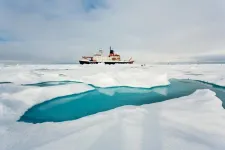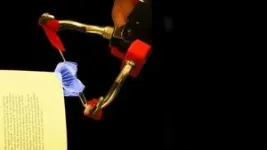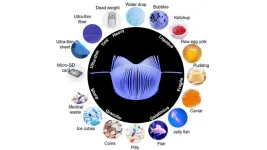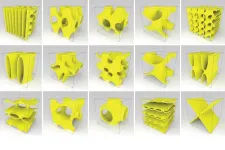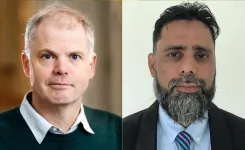(Press-News.org) On Thursday, 3 August 2023, the research vessel Polarstern is scheduled to set off from Tromsø, Norway, towards the North Pole. For two months, a good fifty scientific expedition participants will explore the Arctic in transition as sea ice extent reaches its annual minimum in September. They will explore the biology, chemistry and physics of sea ice as well as the effects of sea ice retreat on the entire ocean system from the surface to the deep sea. Eleven years ago, Antje Boetius was part of the largest ever sea ice minumum in the Arctic and its consequences for life in the deep sea. Now she is returning with her team to compare the state of the Arctic today - also with the data from the MOSAiC expedition 2019/20.
“I am very excited to see how sea ice and ocean life have changed over the last decade,” says Antje Boetius. “In 2012, we were on site during the lowest documented summer sea ice extent to date and were able to see significant impacts on the entire ecosystem of the central Arctic Ocean, down to over four kilometres of water depth,” explains the Director of the Alfred Wegener Institute, Helmholtz Centre for Polar and Marine Research (AWI). “At the moment, I am monitoring the sea ice situation at www.meereisportal.de particularly intensively. We don’t yet know whether a new minimum will be reached, given the globally hot year 2023 and the fact that the sea ice in Antarctica is at a record low.”
The head of the sea ice physics team and MOSAiC expert Dr Marcel Nicolaus reports: “The ice currently covers an area of just under 7.5 million square kilometres, similar to that of the past two years. This means that there is still about one million square kilometres more ice than in 2012. However, the summer melt is in full swing, and the wind in particular will determine how the porous, brittle ice continues to be distributed in the coming weeks.”
The expedition team is investigating in detail how the composition of the sea ice is changing on site: Helicopter-towed sensors are used to measure sea ice thickness, ice cores allow the sea ice composition to be analysed and algae living in the ice to be studied. An underwater robot measures how much light passes through the ice into the ocean when its surface is still covered by snow or already by melt water ponds. The light is available to micro algae (phytoplankton) as a source of energy for photosynthesis, which live in the upper water layers. What happens to the carbon they bind is being researched (micro-)biologically, chemically and physically from the water surface to the deep-sea floor. The planktologists on board want to follow the path of life directly under the ice into the deep sea, for which they bring out various camera systems as well as autonomous samplers.
Several so-called ice stations are planned for the work: “The ship docks at a floe, then the ice researchers go onto the floe, we deploy various robots and free-fall devices and, in parallel, we look at the creatures at the bottom with the zoologists, more than 4000 metres below. In this way, we recognise connections in all levels of the ocean from the sea ice to the seabed,” explains Antje Boetius. In doing so, the team is returning to the same working areas as in 2012 for comparative studies: to the particularly productive marginal ice zone and regions with perhaps still perennial ice cover in the central Arctic. A range of proven but also new technologies will be used for the work, for example lander systems, deep-sea crawlers and the Ocean Floor Observation and Bathymetry System (OFOBS) developed at the AWI. The return takes place after the summer ice melt, when the autumn sea ice formation begins.
Among the participants is a camera team from UFA Documentary GmbH, which is filming the expedition. The television documentary, which is being produced in cooperation with NDR, is scheduled to be broadcast on ARD at the turn of the year. Already during the expedition, interested parties can gain impressions from on board in the radio program of Radio Bremen and of course also follow the expedition in the Polarstern app (https://follow-polarstern.awi.de/?lang=en) and on the social media channels of the Alfred Wegener Institute. Polarstern is scheduled to return to its home port of Bremerhaven on 1 October.
END
Eyewitnesses to Arctic Change
AWI Director Antje Boetius leads Polarstern expedition to the Central Arctic
2023-08-02
ELSE PRESS RELEASES FROM THIS DATE:
New neuroimaging approach could improve diagnosis of schizophrenia
2023-08-02
ATLANTA — New research led by scientists working with Georgia State University’s TReNDS Center has identified age-related changes in brain patterns associated with the risk for developing schizophrenia.
The discovery could help clinicians identify the risk for developing mental illness earlier and improve treatment options. The study is published in the Proceedings of the National Academy of Sciences (PNAS).
The research is part of a collaboration by experts from the University of Bari Aldo Moro, the Lieber Institute of Brain Development and the Tri-institutional Center for Translational Research in ...
Scientists discover unusual ultrafast motion in layered magnetic materials
2023-08-02
A common metal paper clip will stick to a magnet. Scientists classify such iron-containing materials as ferromagnets. A little over a century ago, physicists Albert Einstein and Wander de Haas reported a surprising effect with a ferromagnet. If you suspend an iron cylinder from a wire and expose it to a magnetic field, it will start rotating if you simply reverse the direction of the magnetic field.
“Einstein and de Haas’s experiment is almost like a magic show,” said Haidan Wen, a ...
New review calls on Hockey Canada to raise age of body contact from 13 to 15
2023-08-02
Hockey leagues in Canada should overhaul current rules and regulations to raise the age of bodychecking in the game from 13 to 15, says new research into the effect of body contact on teens.
The literature review was led by Dr. Kristian Gouletnorth_eastexternal link of the University of Ottawa’s Faculty of Medicine and Children’s Hospital of Eastern Ontario (CHEO) and calls on provincial and territorial governments to mandate schools – including those involved with school sports – and sports organizations to establish, ...
Robotic grippers offer unprecedented combo of strength and delicacy
2023-08-02
Researchers at North Carolina State University have developed a robotic gripping device that is gentle enough to pick up a drop of water, strong enough to pick up a 6.4 kilogram (14.1 pound) weight, dexterous enough to fold a cloth, and precise enough to pick up microfilms that are 20 times thinner than a human hair. In addition to possible manufacturing applications, the researchers also integrated the device with technology that allows the gripper to be controlled by the electrical signals produced by muscles in the forearm, demonstrating its potential for use with robotic prosthetics.
“It is difficult ...
The Power of host social interactions in bacterial evolution
2023-08-02
Previous studies in humans and animals showed that hosts in a social condition (sharing the same space) harbor a more similar microbiota composition. Microbial transmission between hosts, which is increased when living in the same household, leads to similar species inhabiting the gut. However, whether bacterial evolution in the gut is affected by microbiota transmission remained unknown.
To fill this knowledge gap, the researchers used an innovative in vivo experimental evolution approach, which revealed an average transmission rate ...
Waves of charge signal rare physics at work inside a superconductor
2023-08-02
‘A place for everything and everything in its place’–making sense of order, or disorder, helps us understand nature. Animals tend to fit nicely into categories: Mammals, birds, reptiles, whatever an axolotl is, and more. Sorting also applies to materials: Insulator, semiconductor, conductor, and even superconductor. Where exactly a material lands in the hierarchy depends on a seemingly invisible interplay of electrons, atoms, and their surroundings.
Unlike animals, the boundaries are less sharp, and tweaking a material’s ...
New method simplifies the construction process for complex materials
2023-08-02
Engineers are constantly searching for materials with novel, desirable property combinations. For example, an ultra-strong, lightweight material could be used to make airplanes and cars more fuel-efficient, or a material that is porous and biomechanically friendly could be useful for bone implants.
Cellular metamaterials — artificial structures composed of units, or cells, that repeat in various patterns — can help achieve these goals. But it is difficult to know which cellular structure will lead to the desired properties. Even if one focuses on structures made of smaller building blocks like interconnected beams or ...
Dimensions to boost discoverability of Oxford University Press online journals and books
2023-08-02
The world’s largest linked research database, Dimensions, will grow its knowledge base even further, thanks to a new partnership with the world’s largest university press, Oxford University Press (OUP).
Under the agreement, more than 27,000 books and 500 journal titles from OUP’s Oxford Academic digital publishing platform will be fully indexed and discoverable in Dimensions, adding another rich resource of academic material to the world’s largest research database, in fields such as the arts, humanities, economics, science, technology, history, and politics.
The move will enable users of Dimensions – a flagship Digital Science product – ...
A visual feast
2023-08-02
3D light sculptures. Tsunami waves on a beach. Previewing color tattoos. Contributions from the Bickel and Wojtan groups at the Institute of Science and Technology Austria (ISTA) to the 2023 SIGGRAPH conference tackle an impressive variety of classic and novel questions. While their focuses range from computer graphics to fabrication methods, the computer scientists are united in finding cost-effective, innovative solutions and empowering users.
SIGGRAPH is the top worldwide annual convention for computer graphics and interactive techniques, bringing ...
Important step toward next-generation probiotics
2023-08-02
One of the beneficial gut bacteria residing in the human gut, which normally cannot survive in an environment with oxygen, can now be made oxygen-tolerant. This is a key finding in the development of future probiotic treatment that is now being explored to improve glucose control in individuals with prediabetes.
Our intestines are home to trillions of bacteria, the gut microbiota, which are important for functions such as digesting food and educating and activating the immune system. During the past decade it has been clarified that changes in the bacterial composition can be linked to various diseases.
Significant expectations have been attributed to the next generation ...
LAST 30 PRESS RELEASES:
An iron-on electronic circuit to create wearable tech
When you’re happy, your dog might look sad
Subnational income inequality revealed: Regional successes may hold key to addressing widening gap globally
Protein puppeteer pulls muscle stem cells’ strings
Study: A genetic variant may be the reason why some children with myocarditis develop heart failure, which could be fatal
Social justice should not be tokenistic but at the heart of global restoration efforts
A new kind of copper from the research reactor
Making simulations more accurate than ever with deep learning
Better predicting the lifespan of clean energy equipment, towards a more efficient design
Five ways microplastics may harm your brain
Antibody halts triple-negative breast cancer in preclinical models
Planned birth at term reduces pre-eclampsia in those at high risk
Penguins starved to death en masse, study warns, as some populations off South Africa estimated to have fallen 95% in just eight years
New research explains how our brains store and change memories
Space shuttle lessons: Backtracks can create breakthroughs
New study finds cystic fibrosis drug allows patients to safely scale back lung therapies
From field to lab: Rice study reveals how people with vision loss judge approaching vehicles
Study highlights underrecognized link between kidney disease and cognitive decline
Researchers find link between psychosocial stress and early signs of heart inflammation in women
Research spotlight: How long-acting injectable treatment could transform care for postpartum women with HIV
Preempting a flesh-eating fly’s return to California
Software platform helps users find the best hearing protection
Clean hydrogen breakthrough: Chemical lopping technology with Dr. Muhammad Aziz (full webinar)
Understanding emerges: MBL scientists visualize the creation of condensates
Discovery could give investigators a new tool in death investigations
Ultrasonic pest control to protect beehives
PFAS mixture disrupts normal placental development which is important for a healthy pregnancy
How sound moves on Mars
Increasing plant diversity in agricultural grasslands boosts yields, reducing reliance on fertilizer
Scientists uncover a new role for DNA loops in repairing genetic damage
[Press-News.org] Eyewitnesses to Arctic ChangeAWI Director Antje Boetius leads Polarstern expedition to the Central Arctic
